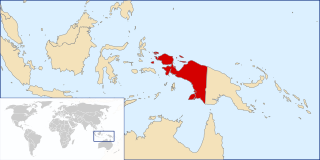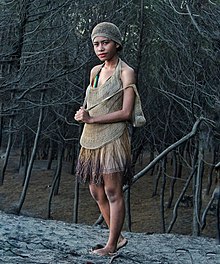
Papua, is a province of Indonesia, comprising the northern coast of Western New Guinea together with island groups in Cenderawasih Bay to the west. It roughly follows the borders of Papuan customary region of Tabi Saireri. It is bordered by the sovereign state of Papua New Guinea to the east, the Pacific Ocean to the north, Cenderawasih Bay to the west, and the provinces of Central Papua and Highland Papua to the south. The province also shares maritime boundaries with Palau in the Pacific. Following the splitting off of twenty regencies to create the three new provinces of Central Papua, Highland Papua, and South Papua on 30 June 2022, the residual province is divided into eight regencies (kabupaten) and one city (kota), the latter being the provincial capital of Jayapura. The province has a large potential in natural resources, such as gold, nickel, petroleum, etc. Papua, along with four other Papuan provinces, has a higher degree of autonomy level compared to other Indonesian provinces.

Dutch New Guinea or Netherlands New Guinea was the western half of the island of New Guinea that was a part of the Dutch East Indies until 1949, later an overseas territory of the Kingdom of the Netherlands from 1949 to 1962. It contained what are now Indonesia's five easternmost provinces, Central Papua, Highland Papua, Papua, South Papua, and West Papua, which were administered as a single province prior to 2003 under the name Irian Jaya, and now comprise the Papua region of the country.
The transmigration program was an initiative of the Dutch colonial government and later continued by the Indonesian government to move landless people from densely populated areas of Indonesia to less populous areas of the country. This involved moving people permanently from the island of Java, but also to a lesser extent from Bali and Madura to less densely populated areas including Kalimantan, Sumatra, Sulawesi, Maluku and Papua. The program is currently coordinated by Ministry of Villages, Development of Disadvantaged Regions, and Transmigration.

West Papua, formerly Irian Jaya Barat, is a province of Indonesia. It covers the two western peninsulas of the island of New Guinea, the Bird's Head Peninsula and the Bomberai Peninsula, along with nearby islands. The province is bordered to the north by the Pacific Ocean, to the west by the Halmahera Sea and the Ceram Sea, to the south by the Banda Sea, and to the east by the province of Central Papua and the Cenderawasih Bay. Manokwari is the province's capital, while Sorong is its largest city. West Papua is the fourth-least populous province in Indonesia, with a population of 1,134,068 at the 2020 Census; the official estimate for mid 2021 was 1,156,840.

The indigenous peoples of West Papua in Indonesia and Papua New Guinea, commonly called Papuans, are Melanesians. There is genetic evidence for two major historical lineages in New Guinea and neighboring islands. A first wave from the Malay Archipelago perhaps 50,000 years ago when New Guinea and Australia were a single landmass called Sahul and, much later, a wave of Austronesian people from the north who introduced Austronesian languages and pigs about 3,500 years ago. They also left a small but significant genetic trace in many coastal Papuan peoples.
The Bauzi or Baudi tribe consists of a group of 2,000 people living in the north-central part of the Indonesian province of Papua. The Bauzi area consists of much of the west side of lower Mamberamo River area in northern Papua. The Bauzi people lived on hunting and gathering in the jungle. While the Bauzi people were historically an animistic people group, they are now 65% Christian. For the most part, tribal warfare is no longer a large part of Bauzi culture and all Bauzi people speak the same language. In recent years, linguists have been studying the language and translating various literature, including the Bible, into the Bauzi language.

Western New Guinea, also known as Papua, Indonesian New Guinea, or Indonesian Papua, is the western portion of the Melanesian island of New Guinea which is administered by Indonesia. Since the island is alternatively named as Papua, the region is also called West Papua. Lying to the west of Papua New Guinea and considered a part of the Australian continent, the territory is almost entirely in the Southern Hemisphere and includes the Schouten and Raja Ampat archipelagoes. The region is predominantly covered with ancient rainforest where numerous traditional tribes live such as the Dani of the Baliem Valley although a large proportion of the population live in or near coastal areas with the largest city being Jayapura.

Ekari is a Trans–New Guinea language spoken by about 100,000 people in the Paniai lakes region of the Indonesian province of Papua, including the villages of Enarotali, Mapia and Moanemani. This makes it the second-most populous Papuan language in Indonesian New Guinea after Western Dani. Language use is vigorous. Documentation is quite limited.
The Koteka are seven major ethnicities of the highlands of Western New Guinea in Indonesia with a common culture: the Lani, Mee, Amungme, Moni, Damal, Yali and Nduga. The Koteka share their identity with other peoples in southern areas, such as the Muyu, Mandobo and Kamoro.
The Paniai Lakes languages, also known as the Wissel Lakes or Wissel Lakes – Kemandoga River, are a small family of closely related Trans–New Guinea languages spoken in the Paniai Lakes region of the highlands of Western New Guinea in the Paniai Lakes region of Papua. Foley (2003) considers their Trans–New Guinea status to be established.

New Guinea is the world's second-largest island with an area of 785,753 km2 (303,381 sq mi). Located in Oceania in the southwestern Pacific Ocean, the island is separated from Australia by the 150-kilometre wide Torres Strait, though both landmasses lie on the same continental shelf. Numerous smaller islands are located to the west and east. The eastern half of the island is the major land mass of the independent state of Papua New Guinea. The western half, known as Western New Guinea, forms a part of Indonesia and is organized as the provinces of Papua, Central Papua, Highland Papua, South Papua, and West Papua. The largest cities on the island are Jayapura and Port Moresby.

The Papua conflict is an ongoing conflict in Western New Guinea between Indonesia and the Free Papua Movement. Subsequent to the withdrawal of the Dutch administration from the Netherlands New Guinea in 1962 and implementation of Indonesian administration in 1963, the Free Papua Movement has conducted a low-intensity guerrilla war against Indonesia through the targeting of its military, police, and civilian populations.

Tembagapura is a district in Mimika Regency, part of the Indonesian province of Central Papua, centered on an urban village built to support the Grasberg Mine. The district covers 2,586.86 km2, and it had a population of 16,917 at the 2010 Census and 23,022 at the 2020 Census.
The Paniai Lakes, originally known as the Wissel Lakes, are the three large, freshwater lakes in the central highlands of Papua, Indonesia: Paniai, Tigi, and Tage. Lakes Paniai and Tage are located in the Paniai Regency, while Lake Tigi is located in Deiyai Regency. The largest of the three is Lake Paniai, while its immediate neighbor Lake Tage is the smallest.
The Wolani or Wodani are a people in the Indonesian Paniai regency (kabupaten) of the Papua province of West Papua. Numbering about 5000 in 1992, they are farmers who live in the central highlands northeast of Lake Paniai, along the Kemandoga and Mbiyandogo rivers. Many Wolani converted to Christianity but, like elsewhere in Indonesia, they retain their traditional religion. They speak Wolani, which is affiliated with the western branch of the Trans–New Guinea languages, similar to the nearby Ekari and Moni languages.

Wolani (Wodani) is a Papuan language spoken by about 5,000 people in the Paniai lakes region of the Indonesian province of Papua. It is related to the Moni, Ekari, Auye, and Dao languages and may be related to the Dani languages. Documentation is quite limited.

The West New Guinea dispute (1950–1962), also known as the West Irian dispute, was a diplomatic and political conflict between the Netherlands and Indonesia over the territory of Dutch New Guinea. While the Netherlands had ceded sovereignty over most of the Dutch East Indies to Indonesia on 27 December 1949 following an independence struggle, it retained control over its colony on the western half of New Guinea. The Indonesian government claimed this territory as well, on the basis that it had belonged to the Dutch East Indies and that the new Republic of Indonesia was the legitimate successor to the former Dutch colony.
The Trans-Papua Highway refers to 12 road segments, some under construction, across Western New Guinea in Indonesia, located in the island of New Guinea. The roads stretch from Sorong to Merauke with a total length of 4,325 km (2,687 mi). As of March 2017, 3,850 km (2,390 mi) of roads had been completed and construction on all the roads was predicted to finish in 2018, but construction was delayed in late 2018 due to armed conflict.
Proto-Trans–New Guinea is the reconstructed proto-language ancestral to the Trans–New Guinea languages. Reconstructions have been proposed by Malcolm Ross and Andrew Pawley.

Central Papua, officially the Central Papua Province is an Indonesian province located in the central region of Western New Guinea. It was formally established on 25 July 2022 from the former eight western regencies of the province of Papua. It covers an area of 66,130.49 km2 and had an estimated population of about 1,409,000 in mid 2021. It is bordered by the Indonesian provinces of West Papua to the west, the residual Papua to the north, and by Highland Papua and South Papua to the east. The designated administrative capital, Nabire, is the second largest town in Central Papua, the economic centre of the province, and the seat of the Central Papua provincial government.











